Sacred Gestures

In Indian art and culture, gestures, or hastas, are not mere hand movements but profound symbols that communicate divine narratives, philosophical concepts, and emotions. Rooted in ancient traditions, these gestures bridge the tangible with the metaphysical, offering insight into the spiritual essence of deities and the cosmic principles they represent. This exploration delves into the iconic hastas of Indian iconography, revealing their significance and their role in shaping the cultural and religious landscape of the subcontinent.
In the rich tapestry of Indian art, hastas—the sacred hand gestures—serve as a vital language through which artists and devotees connect with the divine. These gestures are more than artistic flourishes; they embody the essence of deities, convey cosmic truths, and communicate philosophical principles. Each hasta in Indian iconography, whether in stone sculptures, bronze figures, or classical dance, acts as a bridge between the material and the spiritual world. The abhaya hasta offers protection and reassurance, while the varada hasta signifies the act of giving. Through the nuanced positioning of fingers and hands, these gestures bring forth an intimate portrayal of the divine, emphasizing virtues like wisdom, strength, and benevolence.
From the towering temple sculptures of South India to the subtle mudras in Indian classical dance, these gestures tell stories, express emotions, and invite viewers into a realm where movement and stillness merge to convey deeper meanings. The interconnectedness of the hastas with Indian iconography reflects the broader philosophy of life in Indian thought—where the body, mind, and spirit are inextricably linked to the cosmic whole.
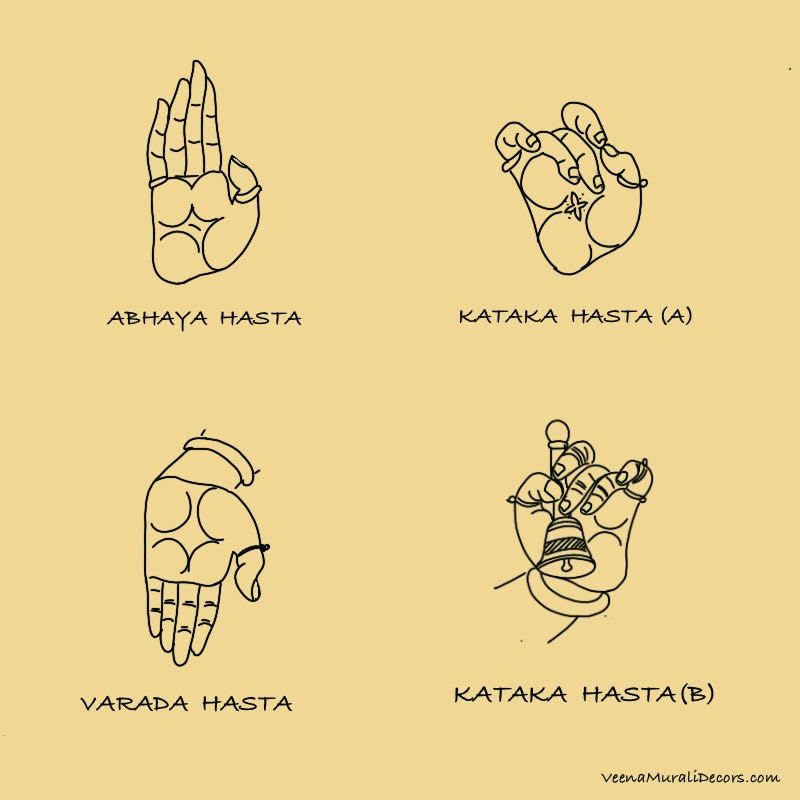
Abhaya Hasta
The *abhaya hasta* conveys protection and reassurance, symbolizing "fearlessness." In this gesture, the fingers are held vertically above the palm, with the thumb bent near the index finger. In sculptures, the hand is positioned near the chest, creating a firm and steady presence. In bronze figures, the fingers can be held more freely, enhancing the beauty of this *mudra*.
Varada Hasta
The *varada hasta* signifies benevolence and giving. It is the *abhaya hasta* turned upside down with the palm facing outward. In stone sculptures, the fingers are bent forward, while in bronze images, they can be slightly more relaxed, representing compassion and tenderness.
Kataka Hasta
The *kataka hasta*, used to hold weapons, is characterized by the thumb curved towards the palm with the middle and ring fingers joined. In sculptures, this gesture is more rigid, while in bronze images, the fingers are held more naturally, suggesting a gentle grip.
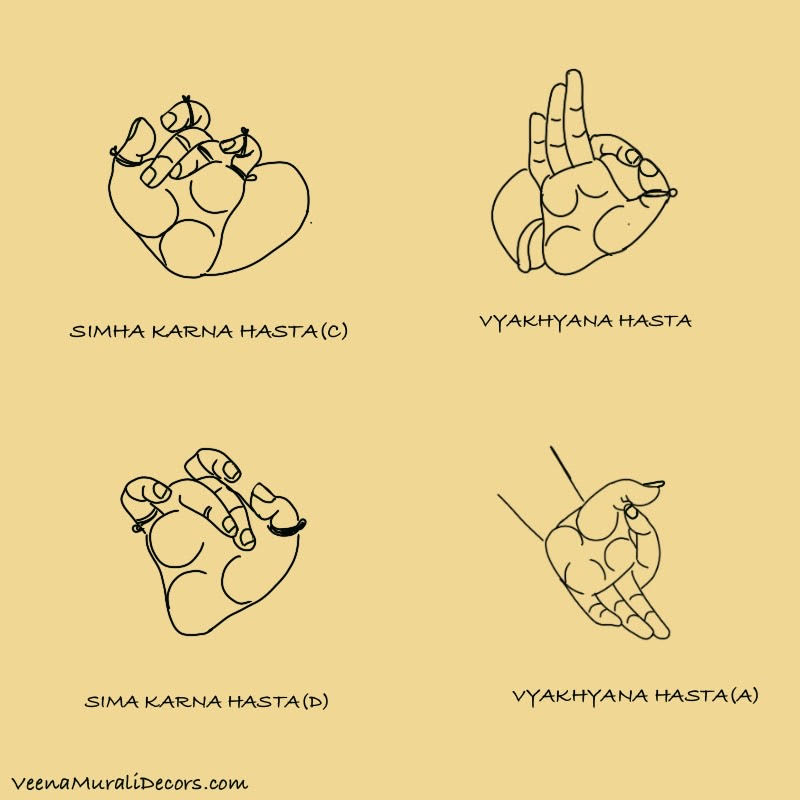
Simha Karna Hasta
Similar to the *kataka hasta*, the *simha karna hasta* has the middle and ring fingers curved further inward into the palm. This *hasta* resembles a lion's ear and is used to evoke power.
Vyakhyana Hasta
The *vyakhyana hasta*, also known as the *chin* or *gnana mudra*, represents wisdom and knowledge. The thumb and index finger touch, symbolizing the union of the individual soul (*jivatman*) with the supreme soul (*paramatman*). This gesture is frequently seen in images of Dakshinamurti and symbolizes liberation.
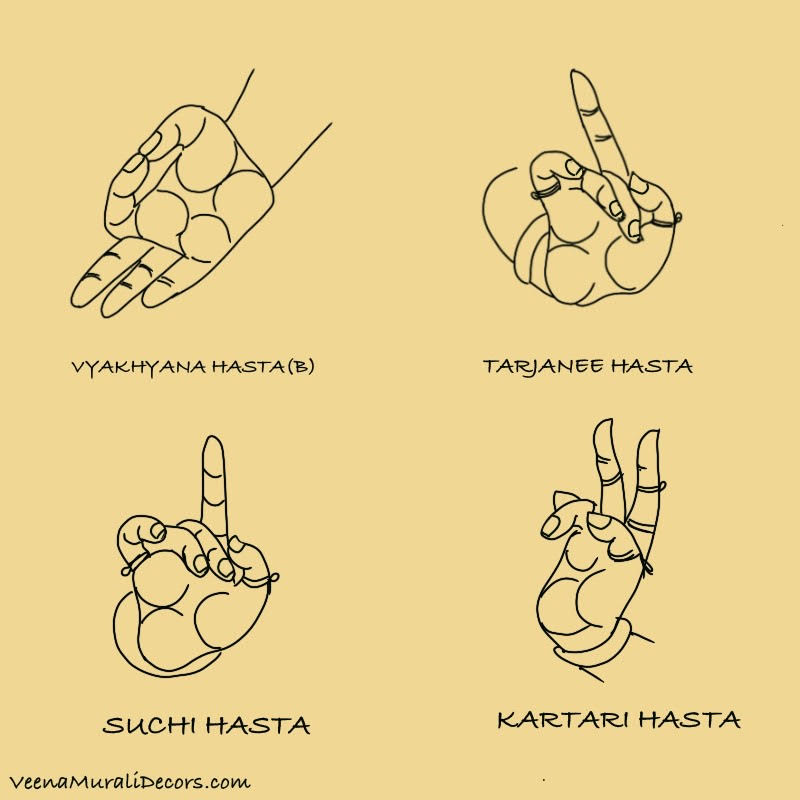
Suchi Hasta
In the *suchi hasta*, the forefinger points vertically upward while the other fingers are in the *kataka hasta* position. It is used to draw attention or to denote retribution. In its variation, *vivartita hasta*, the hand is turned inward and points to oneself.
Kartari Mukha Hasta
The *kartari mukha hasta* is formed with the middle and index fingers separated, resembling scissors. This *mudra* is often used to depict the holding or throwing of weapons, signifying action and precision.
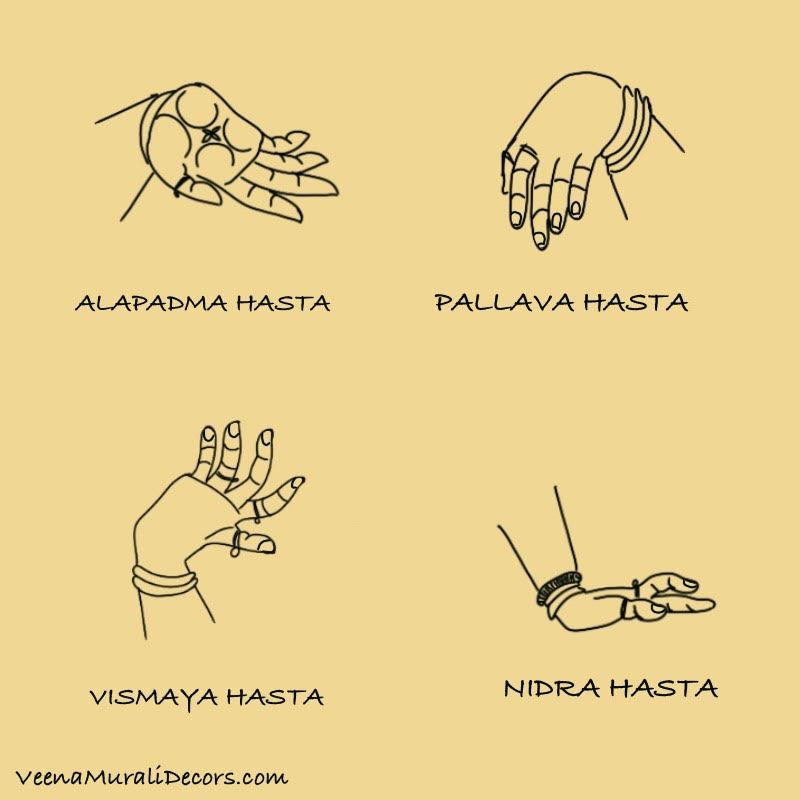
Alapadma Hasta
The *alapadma hasta* resembles an open lotus flower with fingers spread wide. It represents joy and is often used in images of gatekeepers or divine beings in expressive moments of happiness.
Pallava Hasta
In the *pallava hasta*, the fingers are gracefully extended downward, resembling a tender leaf or tendril. This delicate gesture is often seen in images of Shiva, showing a sense of ease and natural grace.
Nidra Hasta
The *nidra hasta* indicates sleep. The hand rests on the ground with the forefinger and little finger slightly raised. It is often used in reclining images like that of Uma or Somaskanda compositions.
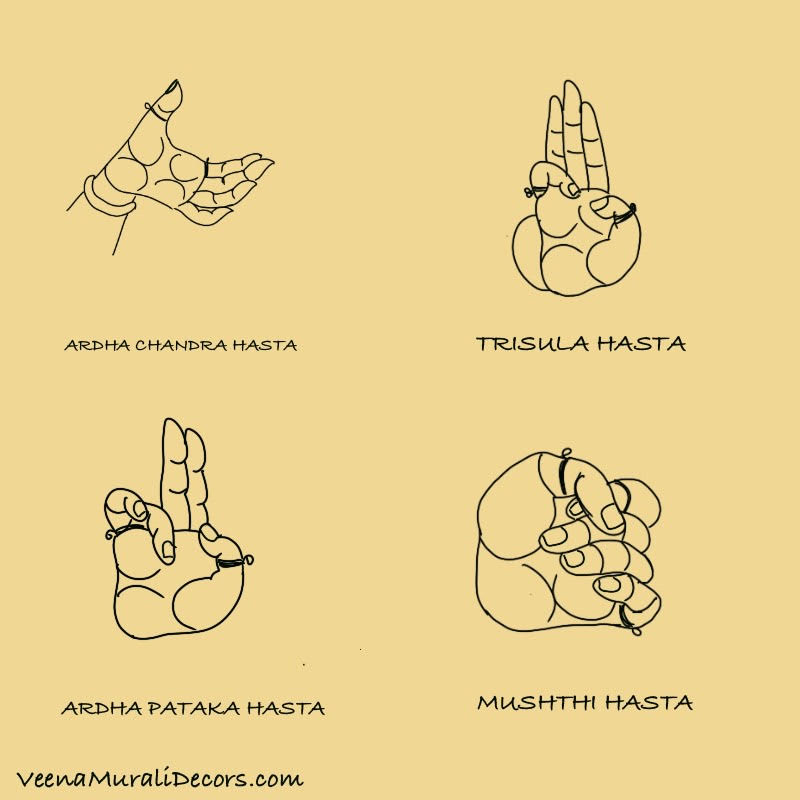
Ardha Chandra Hasta
This *hasta* forms the shape of a half-moon with the thumb extended away from the other fingers, representing balance and duality. The gesture is often used in depictions of divine figures holding objects like a flame.
Trisula Hasta
The *trisula hasta*, symbolizing the trident, is made with the little finger and thumb bent inward, while the other three fingers are extended. It represents the triad of existence—dharma, artha, and kama—as seen in figures like Tiruvalluvar.
Mushthi Hasta
The *mushthi hasta* is a fist, with all fingers curled tightly towards the palm, indicating a firm grip or power. It is commonly used in depictions of warriors or gods holding weapons.
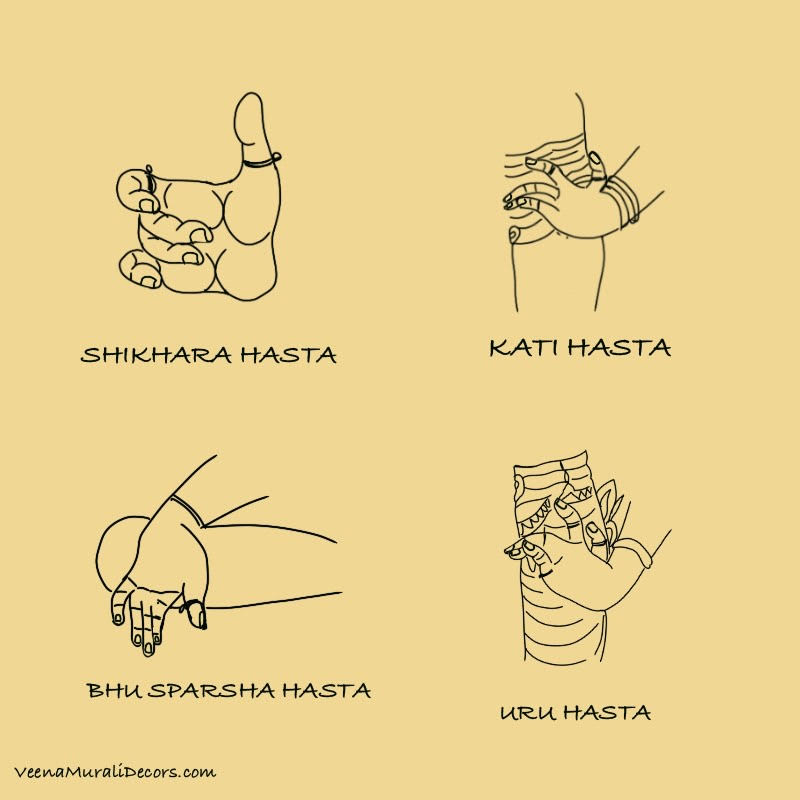
Shikhara Hasta
In the *shikhara hasta*, the thumb points upward while the other fingers are bent into the palm, representing the holding of a bow. This gesture is seen in depictions of deities like Shiva or Rama.
Bhu Sparsha Hasta
The *bhu sparsha hasta*, with fingers touching the ground, signifies enlightenment. It is commonly seen in images of the Buddha, symbolizing his moment of realization.
Kati Hasta
The *kati hasta* is placed at the hip, symbolizing power and regality. This posture, often found in images of Skanda or Vishnu, conveys authority and confidence.
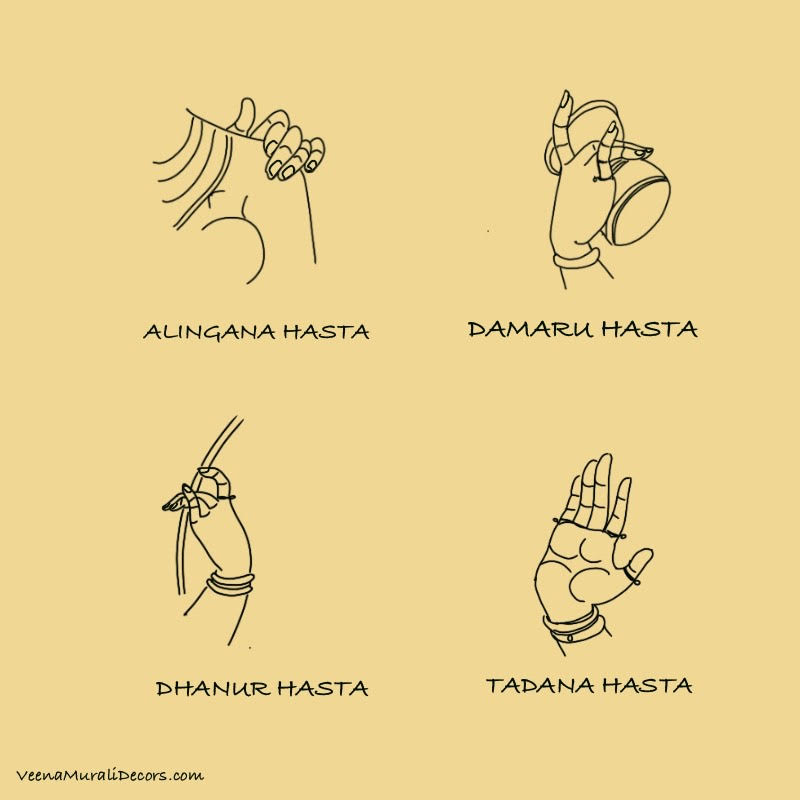
Alingana Hasta
The *alingana hasta* depicts an embrace, with the arm wrapped around another figure, symbolizing love and unity. It is seen in divine couples like Shiva and Parvati or Lakshmi and Narayana.
Dhanur Hasta
The *dhanur hasta* represents holding a bow, with the thumb bent towards the palm and fingers elegantly raised. It conveys strength and focus, as seen in images of Shiva or Rama.
Damaru Hasta
The *damaru hasta* shows the holding of a small drum, with fingers curved inward to suggest rhythm and cosmic vibration. This *mudra* is famously seen in the dancing Nataraja.
Tadana Hasta
The *tadana hasta* signifies punishment or retribution, with the palm facing outward and the fingers tightly together. It embodies discipline and power in divine figures.
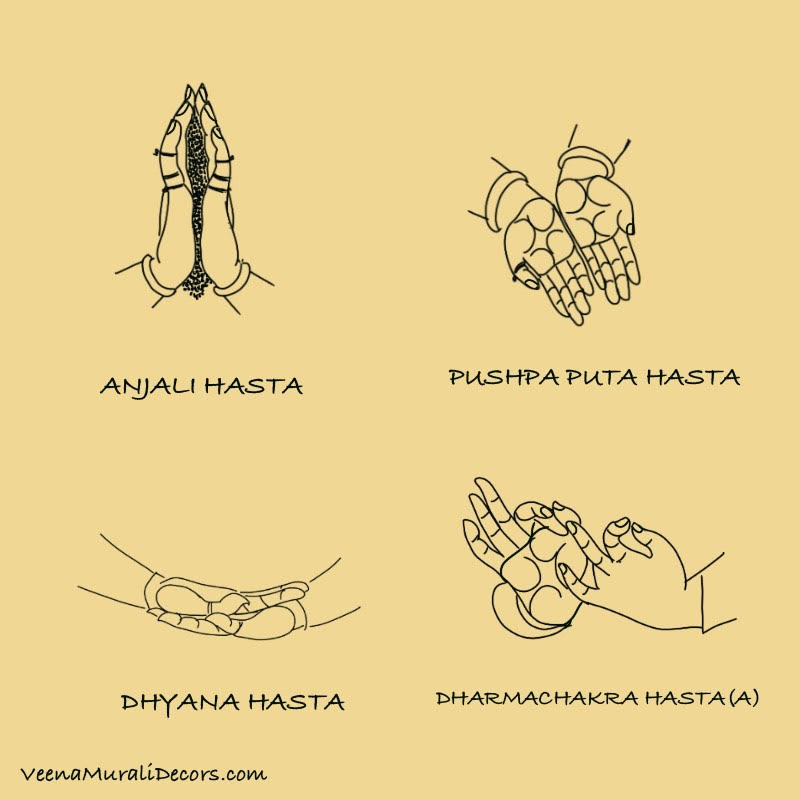

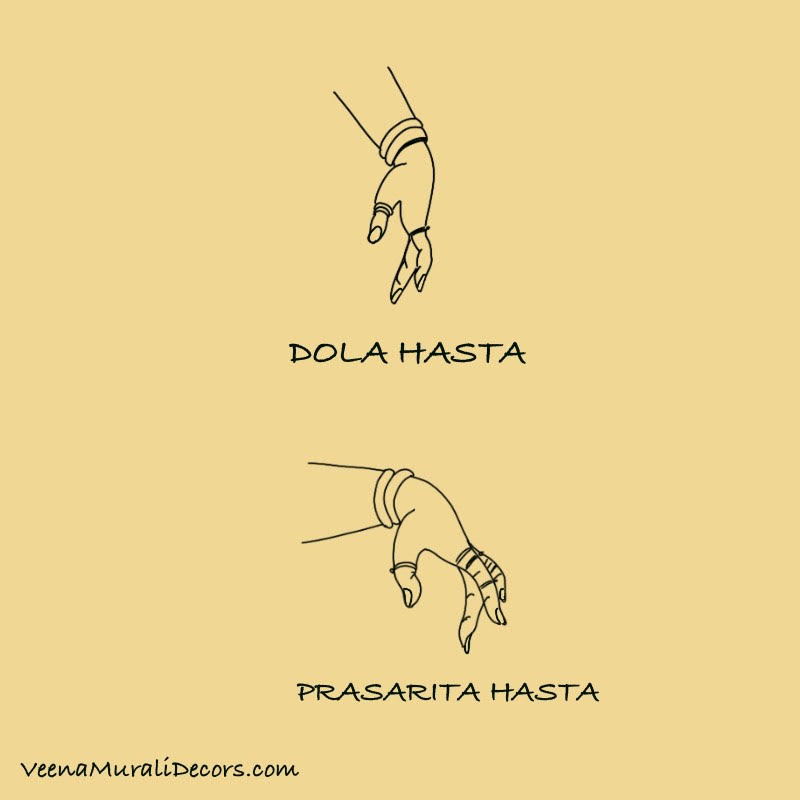
Conclusion:
The sacred gestures of Indian iconography are more than artistic expressions—they are windows into the profound spiritual landscape of Indian culture. Each hasta, with its carefully crafted position, serves as a vessel of divine meaning, speaking directly to the hearts and minds of those who witness them. Whether symbolizing protection, wisdom, or benevolence, these gestures offer a glimpse into the eternal dialogue between humanity and the divine. They stand as a testament to the enduring power of symbolism in Indian art, reminding us that even the subtlest of movements can communicate the most profound of truths. Through these timeless gestures, Indian iconography transcends the boundaries of time and space, continuing to inspire awe, reverence, and spiritual reflection in all who encounter them.
{Images created here are copyrighted by Veena Murali Decors}
Total Views : 1445
Related blogs
.jpg)
Dindigul Lock – Securing the Treasures of Dindigul with a Timeless Lock
The Dindigul lock is more than just a tool; it is a symbol of timeless artistry and masterful ingenuity. Each lock, meticulously handcrafted, embodies the legacy of skilled craftsmen, merging ancient inspiration with unparalleled precision. These locks are not just strong; they are works of art, telling a story of...
Read More.jpg)
Thanjavur Veena: Bringing the Enchanting Sounds to Life
A Little HistoryThe Thanjavur Veena, as its name beautifully reveals, hails from the illustrious Thanjavur region of Tamil Nadu, a land steeped in artistic and musical heritage. From ancient times, this vibrant locale has thrived under the benevolent patronage of the Cholas, Nayakas of Madurai, and the Marathas. It is...
Read More
Nachiyar Koil Lamp-"Illuminating Tradition and Craftsmanship"
In the vibrant heart of Tamil Nadu lies the village of Nachiyar Koil, renowned for a craft that has illuminated sacred spaces and homes for generations: lamp making. This traditional art form, deeply embedded in South Indian culture, transforms raw materials into exquisitely designed lamps serving both functional and ceremonial...
Read More
The Power Of Postures
Postures are more than just physical positions—they are powerful expressions that convey stories, emotions, and deeper meanings. In art and culture, each posture reflects values, beliefs, and aesthetics, shaping how we understand form and movement. This blog explores the significance of postures, from their ancient roots to their lasting impact...
Read More
A Symphony in Wood
Mysore Rosewood InlayAs dawn paints the Mysore Palace in golden hues, its intricate carvings whisper stories of a regal past. Just as the palace embodies artistic grandeur, Mysore’s rosewood inlay work transforms wood into a canvas of heritage and precision.Inspired by the elegance of the Mysore Dasara procession, this craft...
Read More
Kavadi Aattam
A Sacred Journey of Faith, Music, and Devotion In the heart of the Tamil Hindu community, where faith intertwines with tradition, the Kavadi Aattam ritual emerges as a sacred dance of devotion, steeped in centuries-old myths and spiritual significance. It is a journey not only of the body but of the...
Read More.jpg)
Palm Leaf Manuscripts
India, a land of timeless traditions, has long been a guardian of ancient wisdom, preserving knowledge through the delicate strokes of scribes. Long before paper, stories, scriptures, and celestial insights found their way onto nature’s own pages—palm leaves in the south and Bhurjapatra in the north.In the shadow of the...
Read More